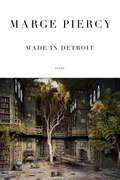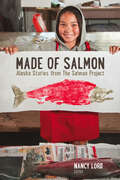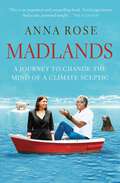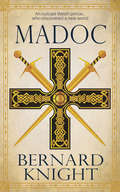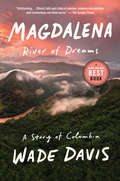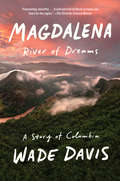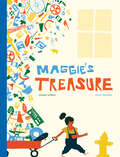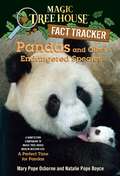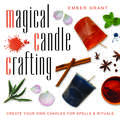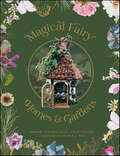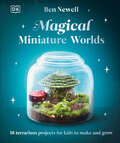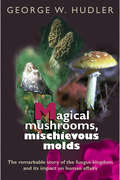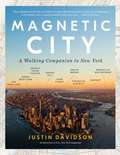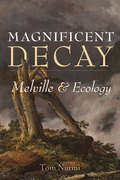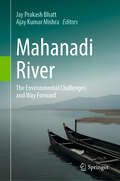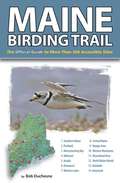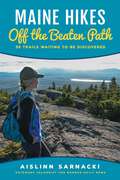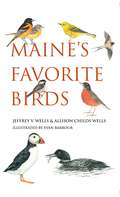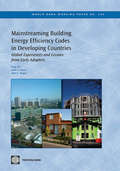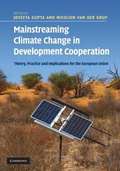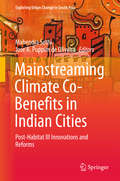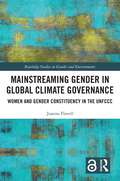- Table View
- List View
Made in Detroit
by Marge PiercyA treasure trove of new poems by one of our most sought-after poets: poems that range from descriptions of the Detroit of her childhood to her current life on Cape Cod, from deep appreciations of the natural world to elegies for lost friends and relationships, from a vision of her Jewish heritage to a hard-hitting take on today's political ironies.In her trademark style, combining the sublime with the gritty, Marge Piercy describes the night she was born: "the sky burned red / over Detroit and sirens sharpened their knives. / The elms made tents of solace over grimy / streets and alley cats purred me to sleep." She writes in graphic, unflinching language about the poor, banished now by politicians because they are no longer "real people like corporations." There are elegies for her peer group of poets, gone now, whose work she cherishes but from whom she cannot help but want more. There are laments for the suicide of dolphins and for her beloved cats, as she remembers "exactly how I loved each." She continues to celebrate Jewish holidays in compellingly original ways and sings praises of her marriage and the small pleasures of daily life.This is a stunning collection that will please those who already know Marge Piercy's work and offer a splendid introduction to it for those who don't.From the Hardcover edition.
Made in the Forest (Fountas & Pinnell Classroom, Guided Reading)
by Jacqueline AdamsNIMAC-sourced textbook. Into the Forest. This is the great Amazon rainforest. What grows there? Who lives there? Come in and see!
Made of Salmon: Alaska Stories from the Salmon Project
by Nancy LordAll over the world, salmon populations are in trouble, as overfishing and habitat loss have combined to put the once-great Atlantic and Pacific Northwest runs at serious risk. Alaska, however, stands out as a rare success story: its salmon populations remain strong and healthy, the result of years of careful management and conservation programs that are rooted in a shared understanding of the importance of the fish to the life, culture, and history of the state. Made of Salmon brings together more than fifty diverse Alaska voices to celebrate the salmon and its place in Alaska life. A mix of words and images, the book interweaves longer works by some of Alaska’s finest writers with shorter, more anecdotal accounts and stunning photographs of Alaskans fishing for, catching, preserving, and eating salmon throughout the state. A love letter to a fish that has been central to Alaska life for centuries, Made of Salmon is a reminder of the stakes of this great, ongoing conservation battle.
Madlands: A Journey to Change the Mind of a Climate Sceptic
by Anna RoseAn idealistic twenty-something environmentalist. A retired right-wing finance minister.All their lives, they've happily ignored each other.Until now.Anna Rose, environmental crusader since the age of fourteen and co-founder of the Australian Youth Climate Coalition, is on a mission. This is the story of her biggest challenge yet: a whirlwind journey around the world with conservative powerbroker and arch climate sceptic Nick Minchin. From a remote Hawaiian volcano to a cosmic ray laboratory in Geneva, Anna rolls out the biggest names in science to try and change Nick's mind.It's a journey to tell the story of what's happening to our climate—not just to one man, but to a nation divided on the biggest issue of our times. Nick and Anna challenge each other's views, provoking each other to confront closely held assumptions and question our responsibilities as citizens living in uncertain times.
Madoc
by Bernard KnightThe epic story of Prince Madoc, son of the ruler of North Wales, who after the death of his wife leaves behind the battles for power and prestige in his homeland and journeys into the unknown, sailing with a small group of companions across the Western Ocean.In this novel, acclaimed author Knight skilfully blends historical fact and the histories of medieval Britain and France with the story of a Welsh prince who, legend says, discovered the continent of North America.
Madoc
by Bernard KnightThe epic story of Prince Madoc, son of the ruler of North Wales, who after the death of his wife leaves behind the battles for power and prestige in his homeland and journeys into the unknown, sailing with a small group of companions across the Western Ocean.In this novel, acclaimed author Knight skilfully blends historical fact and the histories of medieval Britain and France with the story of a Welsh prince who, legend says, discovered the continent of North America.
Magdalena: River of Dreams
by Wade DavisA captivating new book from Wade Davis--award-winning, bestselling author and National Geographic Explorer-in-Residence for more than a decade-- that brings vividly to life the story of the great Río Magdalena, illuminating Colombia's complex past, present, and futureTravelers often become enchanted with the first country that captures their hearts and gives them license to be free. For Wade Davis, it was Colombia. Now in a masterful new book, the bestselling author tells of his travels on the mighty Magdalena, the river that made possible the nation. Along the way, he finds a people who have overcome years of conflict precisely because of their character, informed by an enduring spirit of place, and a deep love of a land that is home to the greatest ecological and geographical diversity on the planet. Only in Colombia can a traveler wash ashore in a coastal desert, follow waterways through wetlands as wide as the sky, ascend narrow tracks through dense tropical forests, and reach verdant Andean valleys rising to soaring ice-clad summits. This rugged and impossible geography finds its perfect coefficient in the topography of the Colombian spirit: restive, potent, at times placid and calm, in moments explosive and wild. Both a corridor of commerce and a fountain of culture, the wellspring of Colombian music, literature, poetry and prayer, the Magdalena has served in dark times as the graveyard of the nation. And yet, always, it returns as a river of life. At once an absorbing adventure and an inspiring tale of hope and redemption, Magdalena gives us a rare, kaleidoscopic picture of a nation on the verge of a new period of peace. Braiding together memoir, history, and journalism, Wade Davis tells the story of the country's most magnificent river, and in doing so, tells the epic story of Colombia.
Magdalena: River of Dreams: A Story of Colombia
by Wade DavisA captivating new book from Wade Davis--award-winning, best-selling author and National Geographic Explorer-in-Residence for more than a decade--that brings vividly to life the story of the great Río Magdalena, illuminating Colombia's complex past, present, and futureTravelers often become enchanted with the first country that captures their hearts and gives them license to be free. For Wade Davis, it was Colombia. Now in a masterly new book, Davis tells of his travels on the mighty Magdalena, the river that made possible the nation. Along the way, he finds a people who have overcome years of conflict precisely because of their character, informed by an enduring spirit of place, and a deep love of a land that is home to the greatest ecological and geographical diversity on the planet. As Gabriel García Márquez once wrote during his own pilgrimage on the river: "The only reason I would like to be young again would be the chance to travel again on a freighter going up the Magdalena." Only in Colombia can a traveler wash ashore in a coastal desert, follow waterways through wetlands as wide as the sky, ascend narrow tracks through dense tropical forests, and reach verdant Andean valleys rising to soaring ice-clad summits. This rugged and impossible geography finds its perfect coefficient in the topography of the Colombian spirit: restive, potent, at times placid and calm, in moments explosive and wild. Both a corridor of commerce and a fountain of culture, the wellspring of Colombian music, literature, poetry, and prayer, the Magdalena has served in dark times as the graveyard of the nation. And yet, always, it returns as a river of life. At once an absorbing adventure and an inspiring tale of hope and redemption, Magdalena gives us a rare, kaleidoscopic picture of a nation on the verge of a new period of peace. Braiding together memoir, history, and journalism, Wade Davis tells the story of the country's most magnificent river, and in doing so, tells the epic story of Colombia.
Maggie’s Treasure
by Jon-Erik LappanoWhen Maggie’s treasure collection grows too big to manage, she finds a creative solution. Maggie finds treasure wherever she goes. Whether it’s a button, a feather or a shiny stone, she picks it up and takes it home. At first the neighbors and city workers are grateful to Maggie for cleaning up; the mayor even gives her an award. But over time Maggie’s collection grows bigger and bigger, until it spills out of her house and garden in an unsightly mess. Her parents tell her “Enough treasure!” and eventually even Maggie realizes that something must be done. Finally, inspired by a bird outside her window, she finds a way to share her treasure that enchants and transforms the entire neighborhood. Jon-Erik Lappano and Kellen Hatanaka, winners of the Governor General’s Literary Award for Tokyo Digs a Garden, have created a stunning picture book about a child who turns her passion for collecting into a pleasure for her community. Correlates to the Common Core State Standards in English Language Arts: CCSS.ELA-LITERACY.RL.1.2 Retell stories, including key details, and demonstrate understanding of their central message or lesson.
Magic Tree House Fact Tracker #26: Pandas and Other Endangered Species (Magic Tree House (R) Fact Tracker #26)
by Mary Pope Osborne Sal Murdocca Natalie Pope BoyceWhen Jack and Annie got back from their adventure in Magic Tree House #48: A Perfect Time for Pandas they had lots of questions. What do pandas eat? Where do they live? Why are snow leopards so scarce? How can we help? Find out the answers to these questions and more as Jack and Annie track the facts. Filled with up-to-date information, photos, illustrations, and fun tidbits from Jack and Annie, the Magic Tree House Fact Trackers are the perfect way for kids to find out more about the topics they discovered in their favorite Magic Tree House adventures.From the Trade Paperback edition.
Magical Candle Crafting: Create Your Own Candles for Spells & Rituals
by Ember GrantWould you like to add a spark of enchantment to your spiritual path and light up your home with a special, warm glow? Candle making is a fun and powerful way to infuse personal energy into your practice and your life.Filled with creative candle recipes and spells, Magical Candle Crafting is a friendly, hands-on guide to making votive candles using inexpensive, easy-to-find items. Ember Grant takes you through each step, from mixing and pouring the wax to choosing magically potent ingredients to charging your candle with energy. Learn to craft candles for rituals specific to the elements, days of the week, chakras, moon phases, planets, and all sabbats on the Wheel of the Year. Discover how to make spell candles for prosperity, love, romance, healing, inspiration, and each of your goals. Further empower your creations with timing guidelines, plus:Inspiring design and decoration ideasRecipes for meditation, rejuvenation, grounding, and mood enhancementSuggestions for herbs, essential oils, crystals, chants, symbols, and other helpful correspondences
Magical Fairy Homes and Gardens
by Barbara Purchia E. Ashley RooneyFairies—those mythical sprites of folktales and daydreams—are an enduring source of fascination to humans. Designing, creating, and maintaining fairy dwellings and gardens has become popular as an artistic endeavor, family activity, or form of meditation. Published in 2014, Purchia and Rooney's Fairy Homes & Gardens has transported thousands of readers to the magical realm of fairy gardening. In the ensuing years, fairy homes and gardens have become much more than a fleeting trend, establishing a perennial pastime for people of all ages. A treasure trove of ideas, this inspiring follow-up features • images and stories of more than 50 new projects that encompass a wide variety of fairy dwellings—communities, cottages, houses, castles, chalets, and other serendipitous structures, • creations by more than two dozen of the most talented and innovative artists creating fairy environments, • a special chapter on fairy accessories, including furniture, doors, swings, and the other creature comforts that fairies appreciate, • an appendix spotlighting plants that are ideal for incorporation into fairy gardens, and • a foreword that tells the story of Florence Griswold Museum's wildly popular Wee Faerie Garden event. Appealing to fairy enthusiasts and nature lovers of all ages, this book provides bold inspiration to help readers embark on a creative and relaxing pursuit that takes them directly into the world of fairy magic.
Magical Miniature Worlds: 18 Terrarium Projects for Kids to Make and Grow
by Ben NewellJoin expert Ben Newell and learn how to create your own tiny world in this children’s terrarium book.This plant book for children aged 7-9 offers practical instructions and loads of exciting ideas for making your own terrarium.Ben Newell clearly explains every step of creating your own terrarium, from picking a container to creating a landscape and choosing the right plants. Once you've mastered the basics, you can let your imagination run wild with these miniature gardens that can be grown in anything from fish tanks to spice jars.This gardening book for kids offers: Content made by terrarium expert Ben Newell. 18 terrarium projects that can be made in any space or environment. Clear, practical guidance and step-by-step instructions on how to build a terrarium.A variety of projects that are themed, including a fairy house, alien landscape, and egg hunt.Why not build a prehistoric jungle complete with dinosaurs? Or a delicate fairy garden? Maybe even an alien world? With 18 different projects to inspire you, you'll be filling your shelves in no time. As well as building terrariums, you'll discover how they work, including all about friendly soil creatures and the water cycle. By learning some of the science behind terrariums, you'll make sure that yours thrives.
Magical Mushrooms, Mischievous Molds
by George W. HudlerMushrooms magically spew forth from the earth in the hours that follow a summer rain. Fuzzy brown molds mischievously turn forgotten peaches to slime in the kitchen fruit bowl. And in thousands of other ways, members of the kingdom Fungi do their part to make life on Earth the miracle that it is. In this lively book, George Hudler leads us on a tour of an often-overlooked group of organisms, which differ radically from both animals and plants. Along the way the author stops to ponder the marvels of nature and the impact of mere microbes on the evolution of civilization. Nature's ultimate recyclers not only save us from drowning in a sea of organic waste, but also provide us with food, drink, and a wide array of valuable medicines and industrial chemicals. Some fungi make deadly poisons and psychedelic drugs that have interesting histories in and of themselves, and Hudler weaves tales of those into his scientific account of the nature of the fungi. The role of fungi in the Irish potato famine, in the Salem Witch Trials, in the philosophical writings of Greek scholars, and in the creation of ginger snaps are just a few of the many great moments in history to grace these pages. Hudler moves so easily from discussing human history to exploring scientific knowledge, all with a sense of humor and enthusiasm, that one can well understand why he is an award-winning teacher both at Cornell University as well as nationally. Few, for instance, who read his invitation to "get out of your chair and take a short walk" will ever again look without curiosity and admiration at the "rotten" part of the world around them. Magical Mushrooms, Mischievous Molds is full of information that will satisfy history buffs, science enthusiasts, and anyone interested in nature's miracles. Everyone in Hudler's audience will develop a new appreciation of the debt they owe to the molds for such common products as penicillin, wine, and bread.
Magnetic City: A Walking Companion to New York
by Justin DavidsonFrom New York magazine’s architecture critic, a walking and reading guide to New York City—a historical, cultural, architectural, and personal approach to seven neighborhoods throughout Manhattan, Brooklyn, and the Bronx, including six essays that help us understand the evolution of the city. For nearly a decade, Pulitzer Prize–winning critic Justin Davidson has explained the ever-changing city of New York to his readers at New York magazine, introducing new buildings, interviewing architects, tracking the way the transforming urban landscape shapes who New Yorkers are. Now, his extensive, inspiring knowledge will be available to a wide audience. An insider’s guide to the architecture and planning of New York that includes maps, photographs, and original insights from the men and women who built the city and lived in it—its designers, visionaries, artists, writers—Magnetic City offers first-time visitors and lifelong residents a new way to see New York. Includes walking tours throughout Manhattan, Brooklyn, and the Bronx • the Financial District • the World Trade Center • the Seaport and the Brooklyn waterfront • Chelsea and the High Line • 42nd Street • the Upper West Side • the South Bronx and Sugar Hill.
Magnetometry in Environmental Sciences: Studying Environmental Structure Changes and Environmental Pollution (GeoPlanet: Earth and Planetary Sciences)
by Maria Jeleńska, Leszek Łęczyński and Tadeusz OssowskiThe book offers a review of the work of the Polish Research Group on selected topics of environmental magnetism: the application of magnetic methods to study pollution of outdoor and indoor air, street dust, polluted soil, air filters and indoor dust; the use of magnetic properties to study pedogenic processes in soils and soil structure; as well as deposition processes in recent sediments. The authors focus on detailed cases and provide in-depth explanations of the causes of and relations between physical processes. The examples of different studies demonstrate how to apply magnetometry to solve problems in related disciplines, how to better understand the complexity of the magnetic structure of substances and mediums as well as how to trace interactions between the environment and natural and anthropogenic factors.
Magnificent Decay: Melville and Ecology (Under the Sign of Nature)
by Tom NurmiWhat is Melville beyond the whale? Long celebrated for his stories of the sea, Melville was also fascinated by the interrelations between living species and planetary systems, a perspective informing his work in ways we now term "ecological." By reading Melville in the context of nineteenth-century science, Tom Nurmi contends that he may best be understood as a proto-ecologist who innovatively engages with the entanglement of human and nonhuman realms. Melville lived during a period in which the process of scientific specialization was well underway, while the integration of science and art was concurrently being addressed by American writers. Steeped in the work of Lyell, Darwin, and other scientific pioneers, he composed stories and verse that made the complexity of geological, botanical, and zoological networks visible to a broad spectrum of readers, ironically in the most "unscientific" forms of fiction and poetry. Set against the backdrop of Melville’s literary, philosophical, and scientific influences, Magnificent Decay focuses on four of his most neglected works— Mardi (1849), Pierre (1852), The Piazza Tales (1856), and John Marr (1888)—to demonstrate that, together, literature and science offer collective insights into the past, present, and future turbulence of the Anthropocene. Tracing the convergences of ecological and literary creativity, Melville’s lesser-read texts explore the complex interplay between inanimate matter, life, and human society across multiple scales and, in so doing, illustrate the value of literary art for representing ecological relationships.
Mahanadi River: The Environmental Challenges and Way Forward
by Ajay Kumar Mishra Jay Prakash BhattThis book covers an overview of the Mahanadi River basin, spanning a total area of 141,581 square kilometers and extending across the states of Chhattisgarh (52.42%), Odisha (47.14%), Maharashtra (0.23%), Madhya Pradesh (0.11%), and Jharkhand (0.1%). It delves into the basin's hydro-development scenario, biodiversity, water quality, and sand mining, elucidating the pivotal role of the river in economic, social, and environmental viability of the eastern region of India. This volume emphasizes the environmental consequences stemming from unsustainable human activities such as river regulation, burgeoning settlements, sand mining, overfishing, and more. The Mahanadi River basin has been less explored for its biodiversity and environmental aspects compared to other prominent river basins like Ganga, Indus, Western Ghats, Godavari, and Krishna. This book seeks to fill this gap, offering new insights into the Mahanadi basin. The chapters address all dimensions of the environment, including social, ecological, engineering, and economic aspects, making it a multidisciplinary work. The book is tailored for audiences with backgrounds in social studies, engineering, biodiversity, and ecology.
Maine Birding Trail: The Official Guide to More Than 260 Accessible Sites
by Bob DuchesneThis is the authorized guide to the Maine Birding Trail, which opens in 2009. The book features more than 260 sites in Maine and includes bonus material on Campobello and Grand Manan islands. Unlike most guides, which emphasize species identification, this book highlights the sites themselves. Bird enthusiasts will count on it to lead them to the best birding locations in Maine and to list the species they will most likely find at each destination.
Maine Hikes Off the Beaten Path: 35 Trails Waiting to Be Discovered
by Aislinn SarnackiWhether you&’re a visitor or a local looking for something different, Maine Hikes Off the Beaten Path leads you through the Pine Tree State with stunning views along the way--from mountaintops to trails and wildlife reserves. In this collection of hikes, Bangor Daily News outdoors reporter Aislinn Sarnacki presents thirty-five hikes around the state that will let you experience the Maine wilderness.
Maine's Favorite Birds
by Jeffrey V. Wells Allison Childs Wells Evan BarbourFrom lush forests and rocky coastlines to lakes, mountains, and rolling fields, spectacular natural beauty and diverse habitats make Maine a wonderful place for seeing and hearing some of North America's most iconic birds. This fresh new book highlights the birds that are loved by Mainers and essential to why millions of tourists visit each year. Written by well-known birders and native Mainers, and based on their years of experience answering questions, leading bird walks, and teaching people about birds, Maine's Favorite Birds puts the focus on Maine's most-loved and best-known birds. This makes the book uniquely suited to bird enthusiasts who want to identify and learn more about the birds around them without the expense and confusion of more advanced field guides. Maine's Favorite Birds features each bird beautifully illustrated in large format, accompanied by clear and concise identification tips, habitat references, and easy-to-remember song descriptions. It also includes birding hot spots and ways birders can put their observations to use for science and conservation. Maine's Favorite Birds is perfect for everyone from kids to grandparents, parents to teachers, Mainers and tourists alike anyone who wants to know and better appreciate the birds they see in backyards, parks, wild areas, and nature preserves.
Mainstreaming Building Energy Efficiency Codes in Developing Countries
by Anke S. Meyer Feng Liu John F. HoganUrbanization and growing wealth in developing countries portend a large increase of demand for modern energy services in residential, commercial and public-service buildings in the coming decades. Pursuing energy efficiency in buildings is vital to energy security in developing countries and is identified by the Intergovernment Panel on Climate Change as having the greatest potential for cost-effective reduction of CO2 emissions by 2030 among all energy-consuming sectors. Building energy efficiency codes (BEECs), along with energy efficiency standards for major appliances and equipment, are broadly recognized as a necessary government intervention to overcome persistent market barriers to capturing the economic potential of energy efficiency gains in the residential, commercial and public-service sectors. Implementation of BEECs help prevent costly energy wastes over the lifecycles of buildings in space heating, air conditioning, lighting, and other energy service requirements. Nonetheless, achieving the full potential of energy savings afforded by more energy-efficient buildings requires holding people who live or work in buildings accountable for the cost of energy services. Compliance enforcement has been the biggest challenge to implementing BEECs. This report summarizes the findings of an extensive literature survey of the experiences of implementing BEECs in developed countries, as well as those from case studies of China, Egypt, India, and Mexico. It also serves as a primer on the basic features and contents of BEECs and the commonly adopted compliance and enforcement approaches. This report highlights the key challenges to improving compliance enforcement in developing countries, including government commitment to energy efficiency, the effectiveness of government oversight of the construction sector, the compliance capacity of building supply chain, and financing constraints. The report notes that the process of transforming a country's building supply chain toward delivering increasingly more energy-efficient buildings takes time and requires persistent government intervention through uniformly enforced and regularly updated BEECs. The report recommends increased international support in strengthening the enforcement infrastructure for BEECs in middle-income developing countries. For low- and lower-middle-income countries, there is an urgent need to assist in improving the effectiveness of government oversight system for building construction, laying the foundation for the system to also cover BEECs.
Mainstreaming Climate Change in Development Cooperation
by Joyeeta Gupta Nicolien van der GrijpClimate change, development and development cooperation are, individually and jointly, three politically sensitive, complex issues, especially in the context of relations between developed and developing countries. This book tackles these issues by combining theoretical, political, and practical perspectives, analysing the dominant paradigms and exploring the meaning of the concept of mainstreaming. At the practical level, it presents the results of case studies focusing on assistance provided by the European Union and key member states and the climate needs articulated by developing countries. At the political level, it highlights the sensitivities between developed and developing countries and examines the mainstreaming debate in various fora. This book is valuable for policymakers, academics, politicians and non-state actors working in the fields of development studies, international law, politics, international relations, economics, climate change, and environmental studies.
Mainstreaming Climate Co-Benefits in Indian Cities: Post-Habitat III Innovations and Reforms (Exploring Urban Change in South Asia)
by Mahendra Sethi Jose A. Puppim de OliveiraThis volume presents a novel framework to understand urban climate co-benefits in India, that is, tackling climate change and achieving sustainable development goals in cities. It utilizes methods and tools from several assessment frameworks to scientifically evaluate sector co-benefits for informed decision making. The co-benefits approach can lead to significant improvements in the way societies use environmental resources and distribute their outputs. The volume discusses four main themes: (1) Concepts and theories on cities and climate co-benefits; (2) Contextualizing co-benefit issues across spatial scales and sectors; (3) Sectoral analyses of co-benefits in energy, transport, buildings, waste, and biodiversity, and (4) Innovations and reforms needed to promote co-benefits in cities. The discussions are based on empirical research conducted in Indian cities and aligned with the international discourse on the 2030 UN Development Agenda and New Urban Agenda created at the UN-Habitat III in 2016. The analyses and recommendations in this volume are of considerable interest to policy experts, scholars and researchers of urban and regional studies, geography, public policy, international development/law, economics, development planning, environmental planning, climate change, energy studies, and so on.
Mainstreaming Gender in Global Climate Governance: Women and Gender Constituency in the UNFCCC (Routledge Studies in Gender and Environments)
by Joanna FlavellThis book explores the role of feminist activists in The United Nations Framework Convention on Climate Change and highlights the progress they have made in mainstreaming gender as a key issue in global climate governance. It is now commonplace for gender to be framed as a political issue in global climate politics within academic scholarship, but there is typically a lack of robust empirical analysis of existing advocacy approaches. Filling this lacuna, Joanna Flavell interrogates the political strategies of the Women and Gender Constituency (WGC) in the UNFCCC (The United Nations Framework Convention on Climate Change). Through a conceptual framework that integrates climate change with intersectional critical inquiry and political practice, Flavell analyses hundreds of historical documents, coupled with interviews and observations from two UNFCCC conferences. This research uncovers a so-far untold story about the history of the UNFCCC that foregrounds gender and feminist advocacy, highlighting the importance of the WGC in shaping dominant narratives of global climate governance through a series of rhetorical and procedural strategies. Overall, the book draws important conclusions around power in global climate governance and opens up new avenues for advancing a feminist green politics. This volume will be of great interest to students and scholars of environmental justice, climate politics and governance, environmental activism, and gender studies more broadly.
